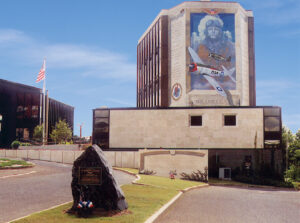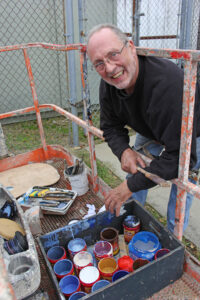
Wall of Remembrance
Dedicated in April 1998
The City of Millville’s Wall of Remembrance Mural — the vision of George M. Curio, World War II veteran B-24 gunner and community leader — was created by mural artist Samuel M. Donovan of Woodstown, NJ, who captured the essence of Millville’s contributions to America’s World War II aviation history on the three-story north wall of Millville City Hall at High and Main Streets (Route 49).
The design illustrates two versions of the Republic P-47 Thunderbolt fighter that was used to train pilots at the Millville Army Air Field during World War II. The aircraft fly majestically before the image of a combat-garbed World War II fighter pilot. The pilot represents and honors Millville’s 14 fallen pilots who died while training at Millville during the war and all of those individuals who gallantly served our country to preserve the freedom we enjoy today.

Millville Army Air Field World War II History Mural
Dedicated in May 2011
This 55-foot mural recognizes the important World War II aviation history of the Millville Army Air Base, America’s First Defense Airport. It was unveiled at a ceremony held on Thursday, May 12, 2011, at Millville Executive Airport.
The mural features images of World War II pilots William Rich and Bernie Borelli, who served at the Millville Army Air Field during World War II as combat flight instructors. Each flew numerous missions in P-47 Thunderbolt fighter-bombers from bases in England during the war. The two pilots, who lived locally until their passing, also served as chairmen of the Millville Army Air Field Museum.
Featured on the mural are images of P-47 Thunderbolts both on the ground and in the air as well as an automobile of the era when the base was an active center for the 10,000 men who served and trained here.
The commemorative mural is located on the side of a 4,000 square foot hangar at the corner of Peterson and Leddon Streets, where it faces incoming traffic looking toward airport runways.

Historic World War II Boresight Range Mural
Dedicated in September 2015 (Located at New Jersey Motorsports Park)
Millville, New Jersey’s Historic Boresight Range is one the last existing examples of what was once an integral part of air base operations for air-to-ground and air-to-air gunnery training during World War II. It is a testament to the aviation technology of this era of American history.
Boresighting is a term used to describe adjustments made to pre-align firearms’ sights for zeroing in (zero drop at X distance) on targets for accuracy.
In the case of the P-47 Thunderbolt fighter-bombers, which were the planes that trained at Millville during World War II from 1942 through 1945 — as with all aircraft of this type — a major factor in “hitting the target” was “harmonization,” or “boresighting,” the alignment of guns and gun sight into a gunfire system.
At the Millville Army Air Field, and at military bases across the United States during World War II, aircraft and pilots prepared to go overseas to fight in the European and Pacific Theatres of war. Their mission was to participate in air battles to protect Allied troops and defeat the enemy by destroying its aircraft, ships and ground sites. Guns fired from these aircraft had to be accurate. Lives depended on this accuracy and there was no tolerance for mistakes.

Link Trainer Flight Simulator Mural
Dedicated in July 2017
The Millville Army Air Field Museum unveiled its fourth World War II-themed mural in Millville Executive Airport’s historic district on July 12, 2017.
It shows a Link Trainer — the only flight simulator used from the 1920s through the early 1950s to teach pilots how to fly under poor visibility conditions. The name was given to an innovative series of flight simulators that were designed and built by Edwin Albert Link at his family business in Binghamton, NY.
The mural is painted on the original World War II Link Trainer Building of the Millville Army Air Field and contains a fully operational Link Trainer, one of just a handful left in the world.
The museum owns three Link Trainers. One of two in the Link Building is of the 1950s era. The other two are a World War II-era.
The Link Trainer became famous during World War II when thousands were produced to help train pilots for war. The United States Army and Navy alone purchased 7,000 of these trainers.
In its day, and for more than 30 years, the Link Trainer was the premier equipment used for instrument flight instruction, up until the introduction of computerized simulators.

MAAFM Commemorative World War II Fire Department Mural
Dedicated in November 2019
The Museum’s Fire Department mural, located in the airport’s historic district, honors the Millville Army Air Field Fire Department that was active during World War II at America’s First Defense Airport.
This mural honors the group of trained Millville civilian firefighters who stepped up to serve as the base fire department from 1943 to 1945, and recognizes all Millville firefighters for their dedicated work protecting the community.
During World War II, the Millville Air Field Fire Department responded to aircraft crashes, on-base fires, and fires in the surrounding woods that were started by gunnery training. In addition, base firefighters were first responders to the crashes that took the lives of each of the 14 pilots who died while training at Millville. When not responding to fires, crews focused on fire prevention and fire safety education.
Of special interest on the fire department mural is the likeness of local photographer and Millville historian Dale Wettstein. While Wettstein was not a World War II veteran, he was a U.S. Army veteran of the Vietnam War who also served as a Millville volunteer fireman for many years and offered dedicated support to the Millville Army Air Field Museum throughout his life.
Air-to-Air Gunnery Training Mural
Dedicated in November 2020 (Located on World War II Building 31, formerly Administrative Office/Base Quartermaster Building)
The P-47 Thunderbolt fighter pilots stationed at the Millville Army Air Field during World War II honed their air-to-air gunnery skills by firing at banner targets towed by the Martin TB-26 Marauder medium bomber aircraft. For training purposes, these were special stripped-down versions of the bomber, being devoid of turrets, guns, and armor plate.
Air-to-air gunnery training at Millville was done at about 10 miles out to sea. The 50-caliber bullets in the P-47s were all coated with a special paint, and each pilot had a different color. As the meshed target was towed approximately 1,200 feet behind the TB-26 Marauder, each Thunderbolt pilot would have his turn firing at it. P-47s generally flew in a formation of three to five aircraft, each peeling off for its shot at the target. When the mission was over, the target would be dropped at the field. Each bullet hole would have a color around it indicating which pilot hit it. This training allowed flight instructors to determine which pilot hit the target and tabulate their accuracy.
A rare original World War II tow target from the Millville base is displayed in the Millville Army Air Field Museum.
The Millville Army Air Field thanked World War II veterans George Washington Whitehouse, flight engineer for the TB-26 at Millville, and Charles “Ozzie” Osborne, P-47 pilot who trained at Millville, for their input in the creation of this mural.

Meet The Artist
Samuel M. Donovan
All six murals, including the Wall of Remembrance mural on Millville City Hall, and the mural depicting the historic boresight range that is located on the property of New Jersey Motorsports Park, were designed and painted by mural artist Samuel M. Donovan from Woodstown, New Jersey. We thank him for his creativity and dedication to the museum’s mission.
Millville Army Air Field Museum’s historic murals and interpretive displays were made possible in part by the New Jersey State Council on the Arts /Department of State, the National Endowment for the Arts, and the Cumberland County Board of Chosen Freeholders through the Cumberland County Cultural & Heritage Commission.


CLICK HERE for the Spanish Translation

CLICK HERE for the Spanish Translation

CLICK HERE for the Spanish Translation







